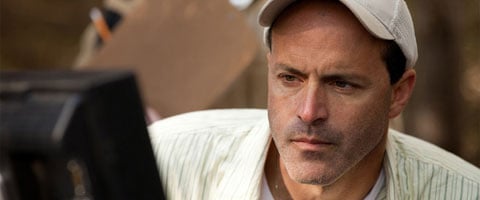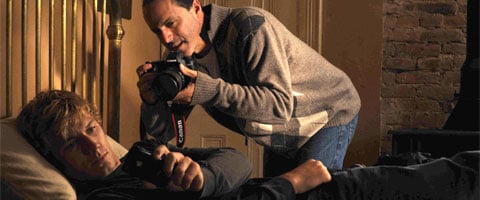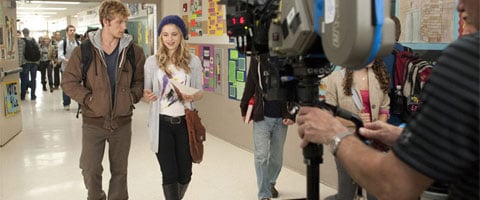Exclusive Interview: I Am Number Four Director D.J. Caruso

D.J. Caruso started his career directing hard dramas like The Salton Sea, Taking Lives, and Two For The Money. Somewhere around 2007, though, the subjects and target demographics for his films quickly changed. He made two films, Disturbia and Eagle Eye, that appealed to much younger audiences and, as a result, raked in blockbuster cash. Now he’s ready to do it again with I Am Number Four.
A couple weeks ago, even before the film was 100% finished, I was given the opportunity to speak with the director one on one to discuss his newest film as well as future projects, touching on subjects like working with young actors and character design. Check out the interview below!
What was it that first attracted you to this project?
First off, I wanted to make a movie that my family definitely could see and go and have a good time, but I also liked the idea of the character of Number Four. I like the idea of this disenfranchised kid who doesn’t really know who he is or doesn’t want to accept who he is and ultimately learns that the world is a little bit more about what you want and about the sacrifices that you have to make and what you have to give up in order to become and accept who you are and your destiny. That sort of character theme and that sort of quirky sci-fi thing and all the little ancillary characters, and I’m a John Hughes nut, so any time you get to go back to high school and fall in love I think it’s a good thing.
To that point, this is the third film you’ve made in a row with a predominantly young cast. What did you take away from working on Disturbia and Eagle Eye that helped you on this film?
Well I think what you learn by having a young cast is that they haven’t developed habits that work for them, because they haven’t figured out, “Okay, I do this and then this and then this and this is what I do,” and some of the great actors I’ve worked with it’s interesting how habitual the process is, you know what I mean? So getting in there as a director might be a little more difficult, but I think what happens is there’s this great sort of clay/moldings that you can help them develop, their style, and at the same time get what you need to get from them and hopefully have them learn more from what you’re doing. So I like the fact that you can, I don’t want to say influence their performance, but they’re a little easier to guide, I think, because they’re not set in their ways.
Is there any particular piece of advice that you gave them that you personally view as important?
Your Daily Blend of Entertainment News
No, because what happens is that everyone’s style is different, like, for example, I really stressed with Alex [Pettyfer] the importance for acting to be organic is how well you listen. So I was always working on Alex and saying, “Really listen, don’t get locked in,” because if someone changes the performance and you’re not listening… so I worked with him on listening and I think other aspects. Callan [McAuliffe] is really good and sometimes Callan can tend to do the same thing. And I would be like, “Look, man, you have that in that take. Here’s what I want you to have in this take.” Everyone takes different things, but there’s not one set advice that works for all actors.

How many takes did you tend to do on set?
It depends.
Put yourself between David Fincher and Clint Eastwood.
[laughs] No, I’m definitely in between for sure, because Clint’s too quick for me. I don’t ever feel about going, “Okay, take two. I’ve got it.” I would say on an average take we’d average 10 or 11.
Going back to that concept of listening, how do you keep the actor in the mindset of the character instead of having them regurgitate lines?
Well I think it depends if it’s one of those dramatic scenes or if there’s a certain organic thing you’re looking for, like, for example, in an argument with Alex and Tim [Olyphant] I might have Tim off-camera to help, or vice versa. So you try to keep in fresh that way. And then, what happens is it ends up losing focus and ends up maybe going flat but sometimes what you might want to do in a Kubrick way is flatten it out because there’s over-dramatic things happening, you know what I mean? So it just depends on the situation.
When this movie was first being developed it was being based on a book that hadn’t yet been completed, and, by the end, there were considerable changes in the story and there are differences between the book and the film.
Absolutely.
Are you at all nervous about fan reaction? There are always fans out there that are absolutely nuts who can’t stand it if even one line of dialogue is changed.
I know, I think so, but what I can’t gauge is what the sort of temperature is of the I Am Number Four book readers yet – how rabid they’re going to be about the changes. So I don’t have the temperature on that, so I just decided I had to, and I talked to all of those involved, it was like I have to figure out how to make the best possible movie that I can because what if this book comes out and it doesn’t sell one copy? [laughs] Right when we were wrapping the books hit the streets, but I don’t know. I felt liberated in a way because I wasn’t locked into so many things. I remember having read the Harry Potter book and then seeing the movie, and seeing the first movie and going, “I don’t understand. I don’t get it, I don’t understand.” So I remember having those feelings and I know some people were going to have those feelings, but I think I had to make the movie work as a whole.

One of the things that changed is the character design. In the books the main villains, the Mogadorians, are actually very human like, but also a lot taller.
And dark eyes or something like that.
What was the character design process like?
It was slightly complicated. At first I probably went too far and then I kind of dialed them back in. Because you want them to be this dark force and to keep their presence sort of coming because as John’s normality, the more and more he falls in love and the more that it triggers his legacies, I needed the Mog force to just keep closing in. And I thought about these images of the trackers in Butch Cassidy and the Sundance Kid or just sort of these old westerns with duster coats. I got sort of hooked on duster coats, and, also, with duster coats you can hide weapons. And the fact that they have this certain height, I wanted them to be, like if they were in the supermarket, just a little bit odd, but not enough, like when the kid looks at him and thinks, “Something’s wrong with that guy” and then everyone else lets him go. That design and having the fact that they can cover up their gills and their facial features lets you know how they can function on Earth. But it was a fun thing and it really was all designed about a visual silhouette – if you were to have one image of what was coming after them, I remember kind of helping and sketching and the artists kind of taking it further about what the Mog threat would be, and it was a really strong silhouette.
With the Lorians, was there ever any consideration to make them look a little less human?
There was talk, but what I did was, like the replicants in Blade Runner way where you can see they were marked with certain kind of [tattoos], I don’t know if you noticed that. So that was kind of a Blade Runner tip. But no, if they had some other feature that was a visual, physical feature, there’s a way it could also be off putting to the audience in a way that would make them seem more abnormal and less human.

One thing that kind of took me by surprise when I first learned about this movie is that, unlike many of the other films in its genre, it wasn’t made in 3D. Was there any point where this film was going to be in 3D?
I wouldn’t give it any consideration because I think – and, again, what Cameron has done with 3D, and I even enjoyed Alice in Wonderland – unless I get a hold of a project that so specific to 3D in that I get to shoot it in 3D, I’m just not a fan of what I call the “Costco Conversion.” [laughs]. But no, it never came up in this, and I think it’s a good reason. There’s also this movie was made with a budget that has a five in front of it, so for what it is, when you have 799 visual effects and you have a five in your budget that’s pretty good. I think it was also a factor from that kind of thing, but I just never saw this in 3D and I’m honestly not a huge fan of it just because you want to make it an event movie.
I was also hoping to ask you about some projects that I’ve read you are attached to. What’s going on with The Defenders with Masi Oka?
I am producing The Defenders and Marti Noxon is writing the script.
The Art of Making Money with Chris Pine.
Art of Making Money… Chris Pine’s schedule is a little funky and we’re still working on the script.
Do you have any idea when it might get going?
I don’t know. What happens with Chris is… the problem, and Chris is not a problem, Chris has to do the Jack Ryan before he does Star Trek, so all of a sudden Chris Pine is going to be off the market.
What about Y: The Last Man?
Y: The Last Man for me, basically, is pretty much dead. It’s just I got where I did as far as I did with New Line and Warners. It’s just, unfortunately, not going to work out.
The book that this movie is based on is also going to be part of a series. Do you see yourself coming back to direct a sequel?
Yeah, definitely. I think if the audience enjoys the movie and they respond the way we hope they respond, have as much fun seeing it as we did making it, then I would definitely come back. For sure.

Eric Eisenberg is the Assistant Managing Editor at CinemaBlend. After graduating Boston University and earning a bachelor’s degree in journalism, he took a part-time job as a staff writer for CinemaBlend, and after six months was offered the opportunity to move to Los Angeles and take on a newly created West Coast Editor position. Over a decade later, he's continuing to advance his interests and expertise. In addition to conducting filmmaker interviews and contributing to the news and feature content of the site, Eric also oversees the Movie Reviews section, writes the the weekend box office report (published Sundays), and is the site's resident Stephen King expert. He has two King-related columns.
